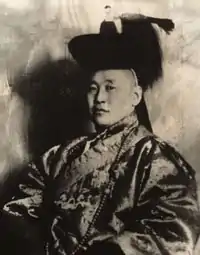Noyan
Noyan was a Central Asian title of authority which was used to refer to civil-military leaders of noble ancestry in the Central Asian Turkic Khanates with origins in Noyon, which was used as a title of authority in the Chagatai Khanate of the Mongol Empire. In modern times, Noyan is used as a given name or surname in Turkey and throughout Central Asia meaning "the commander-in-chief", "the lord", "the protector".[1]
Mongol Empire

Initially, Noyon was a term for the chief of a Mongolian nomad community who, in times of war, had the function as a military commander in the army of Genghis Khan.[2] The term "Noyon" applied to leaders of Tumens and Mingghans, social-military units of 10,000 and 1,000 households respectively, each of them with one recruitable soldier. During conquests, Noyons used to receive territories for administration and they effectively became aristocracy, into the 20th century. Noyons were above the ordinary Mongols in social rank but below the descendants of Genghis Khan. They were sometimes called emir or bey in the Ulus of Jochi, the Ilkhanate and the Chagatai Khanate while the Yuan records gave the equivalent as guanren, since their main task was waging warfare.
Usually, "Noyon" followed the name of a person similar to the usage of the title "Khan" or "Bey".
Qing dynasty
The Qing Dynasty, which ruled Mongolia from 1694 to 1911, entrusted rule in Mongolia to the descendants of Genghis Khan, who were also called Noyon. The term Noyon in this epoch acquired the connotation of nobleman, since Mongolia was mostly at peace. After 1921 the word Darga (boss) replaced the aristocratic Noyon as the term for officials.[3]
Modern Mongolia
In modern Mongolian, the word is used as a form of address similar to "Mister" or "Monsieur".
Notes
- https://charlies-names.com/en/noyan/
- Sneath, David (2007). The Headless State: Aristocratic Orders, Kinship Society, & Misrepresentations of Nomadic Inner Asia. Columbia University Press. p. 114. ISBN 978-0-231-14054-6.
- C.P.Atwood-Encyclopedia of Mongolia, p.412